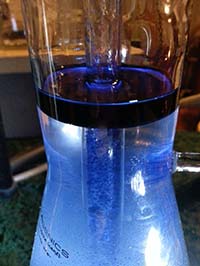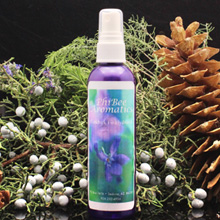WILD YARROW (Achillea millefolium)
By Clare Licher
 For years we had hoped to find enough wild Yarrow somewhere, that we could consider distilling. It finally happened this year! While out collecting Rocky Mt Juniper, I noticed many small patches of Yarrow. We pulled one up to determine how it primarily spreads. The plant had at least 5 rhizomes, and since many of the flowering heads had already gone to seed, it was perfect timing to collect without fear of harming the population. I went back a couple of days later with an assistant, and we spent the entire day collecting over a large area of land. It was both exhausting and exhilarating! We gathered 18.5 lbs., which filled about 2/3 of our 55 gallon distiller.
For years we had hoped to find enough wild Yarrow somewhere, that we could consider distilling. It finally happened this year! While out collecting Rocky Mt Juniper, I noticed many small patches of Yarrow. We pulled one up to determine how it primarily spreads. The plant had at least 5 rhizomes, and since many of the flowering heads had already gone to seed, it was perfect timing to collect without fear of harming the population. I went back a couple of days later with an assistant, and we spent the entire day collecting over a large area of land. It was both exhausting and exhilarating! We gathered 18.5 lbs., which filled about 2/3 of our 55 gallon distiller.
 Yarrow has a reputation of having an extremely low yield of essential oil. Distilled fresh, it yields anywhere between .07% and .25%. Distilled dried, it yields between .25% and .5%. We have found that sometimes distilling a plant dried can compromise the aroma, especially with plants that contain a small amount of camphor. Since it was the first time, we opted to go for aroma over volume, and distilled it fresh. Next time we will probably try it dried to see if there is any difference in aromatic quality. As was predicted, the yield was in the low end of low (.07%, which gave us about 6.5 mls. of oil), but the experience was wonderful. The distillation lasted about 7 hours, and the oil was slow to appear. It was initially a clear color, and the characteristic blue did not show up until about half way through the distillation. Yarrow contains a precursor to azulene, which is converted to azulene through the introduction of steam (chemical extraction without the further use of steam will not produce an oil of blue color from Yarrow). As the distillation continued, the blue color deepened, as did the viscosity of the oil. It was by far the thickest and most difficult oil to decant, and clean out of the condenser (we had to steam it twice to clean all of the visible residue). I could hardly sleep the night of the distillation from all of the excitement, and as I was dozing off, all I could see was the beautiful blue color of the oil.
Yarrow has a reputation of having an extremely low yield of essential oil. Distilled fresh, it yields anywhere between .07% and .25%. Distilled dried, it yields between .25% and .5%. We have found that sometimes distilling a plant dried can compromise the aroma, especially with plants that contain a small amount of camphor. Since it was the first time, we opted to go for aroma over volume, and distilled it fresh. Next time we will probably try it dried to see if there is any difference in aromatic quality. As was predicted, the yield was in the low end of low (.07%, which gave us about 6.5 mls. of oil), but the experience was wonderful. The distillation lasted about 7 hours, and the oil was slow to appear. It was initially a clear color, and the characteristic blue did not show up until about half way through the distillation. Yarrow contains a precursor to azulene, which is converted to azulene through the introduction of steam (chemical extraction without the further use of steam will not produce an oil of blue color from Yarrow). As the distillation continued, the blue color deepened, as did the viscosity of the oil. It was by far the thickest and most difficult oil to decant, and clean out of the condenser (we had to steam it twice to clean all of the visible residue). I could hardly sleep the night of the distillation from all of the excitement, and as I was dozing off, all I could see was the beautiful blue color of the oil.
 While the yield of essential oil is low, the good news is that about 20% of the oil is emulsified in the hydrosol. The aroma is a challenge to describe! While it is not a perfume, the health benefits are numerous. The best reference for exploring Yarrow hydrosol’s benefits is the book, Hydrosols, The Next Aromatherapy, by Suzanne Catty. She has over 30 entries concerning Yarrow’s digestive, detoxifying, skin healing, endocrine and circulatory system supportive properties. She also outlines many protocols for it’s safe and effective use.
While the yield of essential oil is low, the good news is that about 20% of the oil is emulsified in the hydrosol. The aroma is a challenge to describe! While it is not a perfume, the health benefits are numerous. The best reference for exploring Yarrow hydrosol’s benefits is the book, Hydrosols, The Next Aromatherapy, by Suzanne Catty. She has over 30 entries concerning Yarrow’s digestive, detoxifying, skin healing, endocrine and circulatory system supportive properties. She also outlines many protocols for it’s safe and effective use.
I have been using the hydrosol as a general anti-inflammatory tonic and a facial spray to relieve pollen allergies. It has been very effective in reducing itchy and burning eyes.
 The Native American herbal use of Yarrow spans from coast to coast, and from the Aleutian Islands (Alaska) to Arizona. The many varied uses of this plant have been recorded by over 70 different tribes. It is used as a cold remedy, febrifuge, anti rheumatic, heart remedy, kidney aid, liver aid, dermatological aid, gastrointestinal aid, respiratory aid, analgesic, emetic, anti- diarrheal, hemorrhoid remedy, diaphoretic, ceremonial medicine, and the list actually goes on. This is truly a panacea plant.
The Native American herbal use of Yarrow spans from coast to coast, and from the Aleutian Islands (Alaska) to Arizona. The many varied uses of this plant have been recorded by over 70 different tribes. It is used as a cold remedy, febrifuge, anti rheumatic, heart remedy, kidney aid, liver aid, dermatological aid, gastrointestinal aid, respiratory aid, analgesic, emetic, anti- diarrheal, hemorrhoid remedy, diaphoretic, ceremonial medicine, and the list actually goes on. This is truly a panacea plant.
Buy Wild Yarrow Hydrosol here
References:
Guenther, Ernest Ph.D. The Essential Oils Volume 5.
Krieger Publishing Co., Malabar, Florida 1952
Moerman, Daniel. Native American Medicinal Plants, an Ethnobotanical Dictionary. Timber Press, Portland, OR
2009



